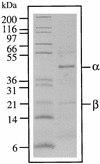Purification and characterization of a membrane-bound hydrogenase from the hyperthermophilic archaeon Pyrococcus furiosus
- PMID: 10852873
- PMCID: PMC101913
- DOI: 10.1128/JB.182.12.3423-3428.2000
Purification and characterization of a membrane-bound hydrogenase from the hyperthermophilic archaeon Pyrococcus furiosus
Abstract
Highly washed membrane preparations from cells of the hyperthermophilic archaeon Pyrococcus furiosus contain high hydrogenase activity (9.4 micromol of H(2) evolved/mg at 80 degrees C) using reduced methyl viologen as the electron donor. The enzyme was solubilized with n-dodecyl-beta-D-maltoside and purified by multistep chromatography in the presence of Triton X-100. The purified preparation contained two major proteins (alpha and beta) in an approximate 1:1 ratio with a minimum molecular mass near 65 kDa and contained approximately 1 Ni and 4 Fe atoms/mol. The reduced enzyme gave rise to an electron paramagnetic resonance signal typical of the so-called Ni-C center of mesophilic NiFe-hydrogenases. Neither highly washed membranes nor the purified enzyme used NAD(P)(H) or P. furiosus ferredoxin as an electron carrier, nor did either catalyze the reduction of elemental sulfur with H(2) as the electron donor. Using N-terminal amino acid sequence information, the genes proposed to encode the alpha and beta subunits were located in the genome database within a putative 14-gene operon (termed mbh). The deduced sequences of the two subunits (Mbh 11 and 12) were distinctly different from those of the four subunits that comprise each of the two cytoplasmic NiFe-hydrogenases of P. furiosus and show that the alpha subunit contains the NiFe-catalytic site. Six of the open reading frames (ORFs) in the operon, including those encoding the alpha and beta subunits, show high sequence similarity (>30% identity) with proteins associated with the membrane-bound NiFe-hydrogenase complexes from Methanosarcina barkeri, Escherichia coli, and Rhodospirillum rubrum. The remaining eight ORFs encode small (<19-kDa) hypothetical proteins. These data suggest that P. furiosus, which was thought to be solely a fermentative organism, may contain a previously unrecognized respiratory system in which H(2) metabolism is coupled to energy conservation.
Figures


Similar articles
-
Intact functional fourteen-subunit respiratory membrane-bound [NiFe]-hydrogenase complex of the hyperthermophilic archaeon Pyrococcus furiosus.J Biol Chem. 2014 Jul 11;289(28):19364-72. doi: 10.1074/jbc.M114.567255. Epub 2014 May 23. J Biol Chem. 2014. PMID: 24860091 Free PMC article.
-
Enzymes of hydrogen metabolism in Pyrococcus furiosus.Eur J Biochem. 2000 Nov;267(22):6541-51. doi: 10.1046/j.1432-1327.2000.01745.x. Eur J Biochem. 2000. PMID: 11054105
-
Engineering the respiratory membrane-bound hydrogenase of the hyperthermophilic archaeon Pyrococcus furiosus and characterization of the catalytically active cytoplasmic subcomplex.Protein Eng Des Sel. 2015 Jan;28(1):1-8. doi: 10.1093/protein/gzu051. Epub 2014 Dec 3. Protein Eng Des Sel. 2015. PMID: 25476267 Free PMC article.
-
The modular respiratory complexes involved in hydrogen and sulfur metabolism by heterotrophic hyperthermophilic archaea and their evolutionary implications.FEMS Microbiol Rev. 2013 Mar;37(2):182-203. doi: 10.1111/j.1574-6976.2012.00346.x. Epub 2012 Jul 12. FEMS Microbiol Rev. 2013. PMID: 22713092 Review.
-
Production and Application of a Soluble Hydrogenase from Pyrococcus furiosus.Archaea. 2015 Oct 12;2015:912582. doi: 10.1155/2015/912582. eCollection 2015. Archaea. 2015. PMID: 26543406 Free PMC article. Review.
Cited by
-
Whole-genome DNA microarray analysis of a hyperthermophile and an archaeon: Pyrococcus furiosus grown on carbohydrates or peptides.J Bacteriol. 2003 Jul;185(13):3935-47. doi: 10.1128/JB.185.13.3935-3947.2003. J Bacteriol. 2003. PMID: 12813088 Free PMC article.
-
Insights into the metabolism of elemental sulfur by the hyperthermophilic archaeon Pyrococcus furiosus: characterization of a coenzyme A- dependent NAD(P)H sulfur oxidoreductase.J Bacteriol. 2007 Jun;189(12):4431-41. doi: 10.1128/JB.00031-07. Epub 2007 Apr 20. J Bacteriol. 2007. PMID: 17449625 Free PMC article.
-
Reinvestigation of the steady-state kinetics and physiological function of the soluble NiFe-hydrogenase I of Pyrococcus furiosus.J Bacteriol. 2008 Mar;190(5):1584-7. doi: 10.1128/JB.01562-07. Epub 2007 Dec 21. J Bacteriol. 2008. PMID: 18156274 Free PMC article.
-
Distinct physiological roles of the three [NiFe]-hydrogenase orthologs in the hyperthermophilic archaeon Thermococcus kodakarensis.J Bacteriol. 2011 Jun;193(12):3109-16. doi: 10.1128/JB.01072-10. Epub 2011 Apr 22. J Bacteriol. 2011. PMID: 21515783 Free PMC article.
-
Homologous expression of a subcomplex of Pyrococcus furiosus hydrogenase that interacts with pyruvate ferredoxin oxidoreductase.PLoS One. 2011;6(10):e26569. doi: 10.1371/journal.pone.0026569. Epub 2011 Oct 24. PLoS One. 2011. PMID: 22039508 Free PMC article.
References
-
- Adams M W W. The structure and mechanism of iron-hydrogenases. Biochim Biophys Acta. 1990;1020:115–145. - PubMed
-
- Adams M W W, Kletzin A. Oxidoreductase-type enzymes and redox proteins involved in fermentative metabolisms of hyperthermophilic archaea. Adv Protein Chem. 1996;48:101–180. - PubMed
-
- Adams M W W, Mortenson L E. The physical and catalytic properties of hydrogenase II of Clostridium pasteurianum. J Biol Chem. 1984;259:7045–7055. - PubMed
-
- Albracht S P J. Intimate relationships of the large and the small subunits of all nickel hydrogenases with two nuclear-encoded subunits of mitochondrial NADH: ubiquinone oxidoreductase. Biochim Biophys Acta. 1993;1144:221–224. - PubMed
-
- Albracht S P J. Nickel hydrogenases: in search of the active site. Biochim Biophys Acta. 1994;1188:167–204. - PubMed
Publication types
MeSH terms
Substances
LinkOut - more resources
Full Text Sources
Other Literature Sources
Molecular Biology Databases

